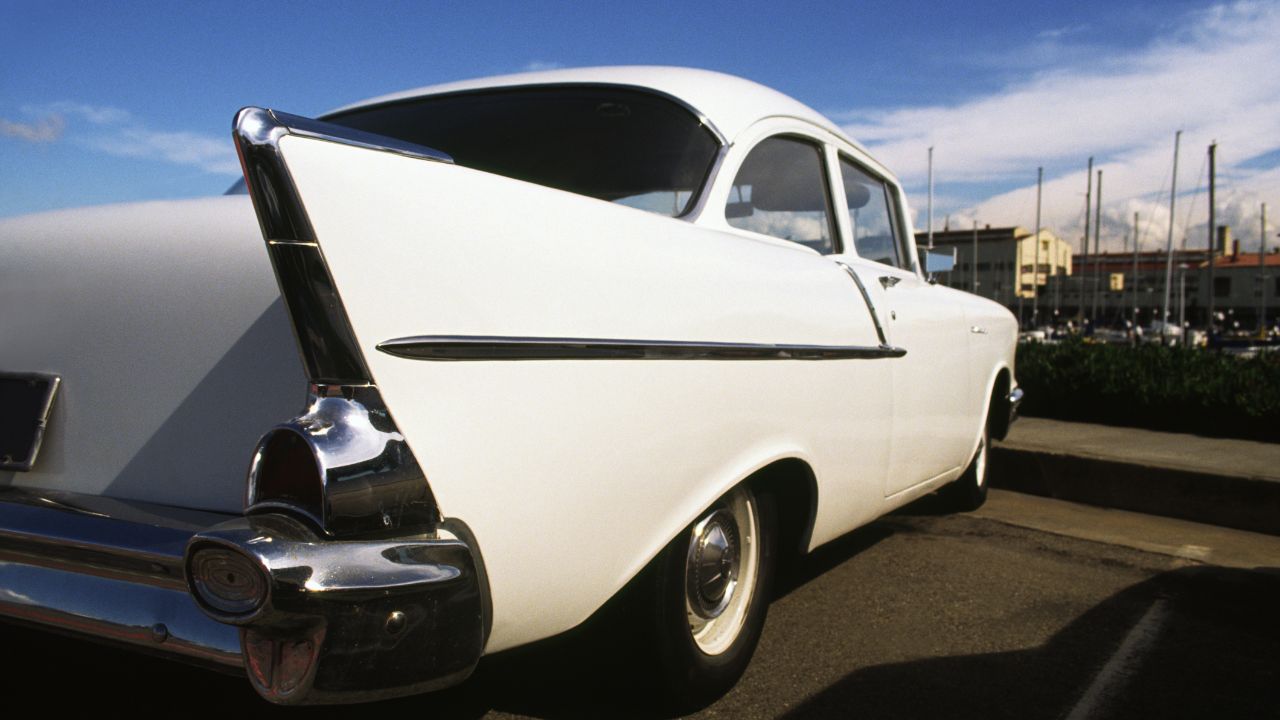
You probably think of the Dodge Charger when you think about 1971 cars. The 1971 Dodge Charger was redesigned with a 115-inch wheelbase, six coupes and three hardtop series, and a more spacious interior than the Ford Torino or Chevy Chevelle. The basic models featured either 318 ci or 6 cylinder engines. There was also an option for the Hemi. The SE and 500 were the new trim levels. These added features included extra sound insulation and carpeting, as well as a three speed manual transmission and wood-grain-plastic.
Chrysler's 1971 cars had automatic headlights and tilt wheel
By 1971, the Chrysler lineup consisted of four-door sedans, two-door hardtops, and wagons. Nearly all of the cars in this range featured the C-body design and a streamlined fuselage. There were also improvements in rear footroom and the installation of automatic headlights. Many models were equipped with tilt steering and automatic headlights. Chrysler also began offering cars with automatic transmissions, which made driving easier.

Chrysler's 1971 cars included automatic temperature control
The first automatic temperature control system was introduced to the Chrysler Imperial in 1967. This was the first model in its class to feature this feature. However, it was also available on all models. It was also standard on Ford Thunderbirds. Even less-expensive cars were available with automatic climate control by the 1970s. The era's best cars had this feature, and the sidebar below lists the most popular models.
Ford's 1971 Mustang Mach 1 had a partial-throttle downshift
One feature was unique to the Mustang Mach I when it was released. Ford tested the part-throttle downshift while on the racetrack. Part-throttle shifting is an option in the car's sixspeed transmission that allows you to accelerate when you are upshifting. Although it isn't available on the Mustang GT this feature was added to Mach 1.
Dodge's 1971 cars used a modified power-steering system to provide better road feel
The Charger body style was introduced by the company in 1971. Although the Coronet was used as the basis for this car, sales of it were disappointing. The car was a 4-door with only the 318- and 6-cylinder engines. The Dodge Coronet was scrapped and replaced by the Charger. This four-door sedan and wagon is available in both wagon and sedan versions. The Charger enjoyed increased popularity after it was redesigned for its 1971 model year.
1971 GM cars had Torsion Quiet Ride
GM's Torsion-Quiet Ride system was introduced in 1971. It was designed to isolate the leaf springs and subframe from each other, reducing noise, vibration, and stiffness. However, it had many drawbacks when cornering. Rick Ehrenberg is a Mopar expert and recommends retrofitting earlier suspension parts in order to increase performance, reduce noise, and improve handling. But what are the benefits of the Torsion-Quiet Ride system?

Ford's 1971 Mustang Mach 1 had a new 360 engine
The 1971 Ford Mustang Mach 1 sports car was the Mustang Mach 1. It was first produced in 1969 and won the SCCA Manufacturer's Road Rally Championship. It replaced the Mustang GT before it and featured a 360 motor. The Ford Mustang Mach 1 won several major races during its production, including the North American Rally Championship. It also won many awards for performance, including "Best of Show" honour.
FAQ
What are the qualifications for an automotive technician
High school graduation or GED is required with excellent grades in English and math. It is also necessary to be able both to read and to write. After passing a written test, you will need to complete a series of practical tests before you are allowed to begin working.
Is it hard being a mechanic apprentice
Although it's not an easy task, you will learn quickly and have many opportunities to advance.
You must be patient and persistent. It is also important to know how you can fix vehicles, trucks, or motorcycles.
There is a lot of pressure from customers and family members who want you to succeed. But you should never feel pressured into making decisions you aren't comfortable with.
This is a career that you might enjoy if you are passionate about fixing cars. You can make a decent living and build your business.
However, you might prefer to go down another route. In this case, you could consider becoming a technician instead.
This involves using your technical expertise to support other workers. Technicians could benefit from your technical expertise to solve problems or teach new techniques.
Another option is to be a service advisor. You will offer assistance and advice to customers when they bring cars to a garage.
It all depends on your goals. There are many options, so you can choose the one that suits you best.
What length is an automotive course?
An automotive course lasts 3 years.
The first year of your training is devoted to theory. You will learn all about cars. The second year is dedicated to practical training, where you will learn how to fix cars, drive them, and do other jobs around the car. The last year is spent at a local shop, where you will get practical experience with real-world problems.
What qualifications do I need to become a mechanic?
To become a mechanic, you'll need to pass a series of exams. These exams include:
-
A general knowledge assessment
-
Practical exam
-
An apprenticeship test
These tests are designed to ensure that you understand the basic concepts of mechanical engineering and physics before you start working as a mechanic.
Once you've passed these tests, you'll be eligible to work as a mechanic. You will still need to complete an apprenticeship. This will involve training in the trade.
To learn all you can about vehicle repair, you will need to take classes and workshops. Working alongside skilled mechanics is also a must.
You'll need a high level of concentration and attention to detail if you want to succeed as a mechanic. Repairs to vehicles require you to pay attention to every detail.
To become a successful mechanic you'll need patience. This may not be the career path that you want if you aren't able to follow directions.
If you enjoy cars and fixing them, this job could be a good fit for you.
To be a car mechanic, do you need a degree? Can I do part-time studies?
It is not essential, but it is helpful. Employers prefer applicants who have completed a full-time degree. It shows that your efforts have been put in and you have succeeded.
You can still study while working, however. Some universities allow students the flexibility to finish coursework during summer vacations and resume their studies later in year. Students can also take classes part time throughout the academic year.
What jobs are available for car mechanics?
For car mechanics, there are three main areas for employment:
-
Automotive repair shops
-
Dealerships
-
Independent garages
Automotive repair shops
This is where most people first think of becoming a mechanic. It's the easiest way for most people to get started. Either work for someone else's shop or you can start your own.
If you plan to work in a shop, you must apply to join the union. Once you have been accepted into the Union, you'll be given training by the union.
After the training, you will be ready to go and start your job.
Register with the government if you want to open your garage. After you register, you will be required to meet specific standards.
When you've registered, you'll be given a license to operate your garage.
Your license allows for minor repairs and spare parts sales. It won't permit you to fix serious engine problems.
Apart from selling spare parts, customers will also expect you to provide guidance and advice.
Dealership jobs
Most dealerships employ mechanics who can specialize in a particular area of the car. They might be able to only fix brakes or replace tires.
However, some dealerships also hire general mechanics who can handle all aspects of car repairs.
These positions often require applicants that they undergo special training before being allowed work. This allows employers to pick the right candidates for their jobs.
Some dealerships recruit students right out of school. These graduates have no difficulty learning about cars because they already know the basics and principles of mechanical engineering.
Independent garages
Independent garages don’t have to be associated with any particular dealer. Instead, they focus on high-quality customer service.
Because independent garages aren't affiliated with any company, they can afford to pay higher wages. This means that these jobs are usually more lucrative than those at dealerships.
However, independent garages may not be better places to work. Many business owners prefer to be in control of their businesses than to delegate it to employees.
It is possible to work long hours, but not have any control over the day.
Also, expect to make lower wages than if your job was at a dealership.
It's possible to switch between jobs. Ask your employer if you would like to work as a mechanic at a dealership.
If you prefer to work in an independent garage, you might consider applying directly to its owner.
It's not always easy to find a job. You can earn more depending on many other factors.
This could include the type of vehicle that you are working on and whether or not you charge an additional for labor.
How can I prepare to become a mechanic apprentice?
It is important to have an understanding of what you are going into. You must understand the workings of cars. This will allow you to be prepared for your first day at work.
Also, you need to know how fix simple problems, such as tires and lights that aren't working.
You will be able to diagnose and repair problems yourself.
You'll also need to know how different parts fit together to put them back together again.
Finally, you need to be able to safely and efficiently use tools.
All these aspects will help you become a competent technician.
Statistics
- According to the BLS, the median annual salary for automotive service technicians and mechanics in the United States was $44,050 in May 2020. (uti.edu)
- The U.S. Bureau of Labor Statistics (BLS) reports that the job outlook for automotive service technicians and mechanics is expected to decline by 4% from 2019 to 2029. (indeed.com)
- According to the BLS, total auto technician employment is expected to exceed 705,000 by 2030. (uti.edu)
External Links
How To
How to become a mechanic certified
The mechanic's certifications can be used by people who wish to become professional automotive technicians. They provide an overview of all areas of auto repair, including engine diagnostics, electrical systems, brakes, suspension, steering, fuel injection, air conditioning, heating, exhaust, transmission, diagnostic tools, body repairs, collision damage repair, collision repair, paintless dent removal, motor vehicle emissions testing, and much more.
The program is composed of 12 hours classroom instruction and three month's on-the-job training at participating dealers. Students must attend 60 hours of classroom instruction per semester. In addition, they must pass a written exam which includes practical and theory questions. The National Institute for Automotive Service Excellence will administer the state exam to students who have completed the coursework. To become an automotive service technician, you will need to be certified by ASE.